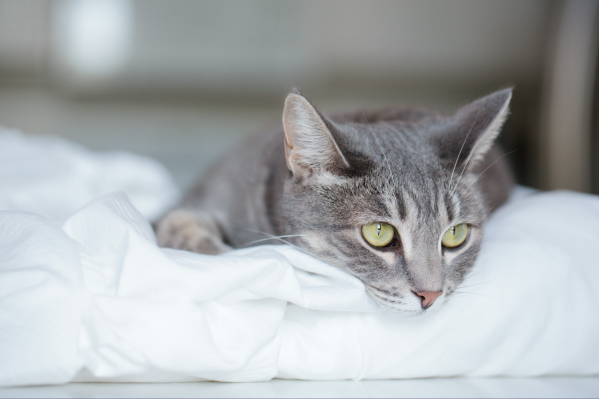Hyperthyroidism is a common disease in cats, typically affecting cats between 5-10 years of age.
Hyperthyroidism is an overproduction of thyroid hormone. It can originate from one of two areas—the thyroid gland itself, which is in the neck of the cat, or from accessory thyroid tissue, which appears on the base of the heart. Both are treated the same way.
While making the diagnosis is relatively easy, treating and managing a hyperthyroid cat can be challenging for both the pet parent and veterinarian.
Let's review clinical signs, diagnoses, and treatment options for hyperthyroidism in cats, as well as potential complications that come with managing a hyperthyroid cat.
Signs of hyperthyroidism in cats
The most common clinical sign of hyperthyroidism in cats is weight loss with a very good appetite. The cat will eat an excessive amount of food and still be losing weight. Pet parents typically notice that they fill the food bowl up more often.
Some less common signs of hyperthyroidism in cats are diarrhea, inappropriate urination, and drinking a lot of water. We’ve even seen not using the litter box like normal as the only sign.
Since a lot of these signs are not specific to hyperthyroidism, veterinarians will run a panel to check for multiple diseases at the same time.
How is hyperthyroidism in cats diagnosed?
Diagnoses is done with lab work, specifically looking at T4. T4 is an inactive version of thyroid hormone, while the active version is T3. Almost all cats if they are hyperthyroid will have an elevated T4 over 7.
In older cats about 7-10 years of age, you can have a grey zone of high T4, in the range of 5-7, with the normal range being between 2-4. If you have an older cat with T4 in the grey zone, then there is additional testing required. That can be a T3 suppression test or more advanced testing done through an endocrinology laboratory.
How is hyperthyroidism in cats treated?
Treatment of hyperthyroidism is done in one of three ways.
The best option is oral therapy with Felimazole, which can be given once or twice daily. Felimazole is a chemotherapy drug, so the tablets should never be split and the medication should be given while wearing gloves. The whole pills have a coating on them that protects humans from the drug and allows it to be better absorbed by your cat.
Topical therapy with a compounded version of Felimazole can also be used as treatment. This is typically placed in the cat's ear and the medicine is absorbed through the skin. The drawback to this is you get inconsistent dosing, some days the whole amount can be absorbed, while other days you may get half or less. With inconsistent dosing you get minimal to no control of the clinical signs.
The third way to treat hyperthyroidism in cats is through radioactive iodine. Radioactive iodine is a cure for hyperthyroidism, so the big drawback is cost. In Michigan where I practice, it is typically about $3,000-$5,000 dollars for the treatment. The cat is hospitalized for up to a week until it is no longer radioactive—but afterwards, your pet cat is cured. It's possible, however, that if you opt for traditional treatment through Felimazole, when you add up the cost of medication, lab work, and rechecks over 5-7 years, you may end up paying the same amount as the radioactive iodine treatment, but it is spread out over a longer period of time.
Managing a hyperthyroid cat for a pet parent is relatively easy, giving a pill once or twice daily. Well maybe not that easy—pilling a cat is the hardest part of the treatment, and it can stress out both the pet parent and the cat. So sometimes we opt for the topical therapy.
If your cat has hyperthyroidism, your veterinarian will want lab work every 6 months to a year. The lab work monitors the kidney values and T4 levels, and your veterinarian will make treatment decisions based off the lab values.
If you have additional questions about hyperthyroidism in cats, the Pawp team is here to help 24/7.
